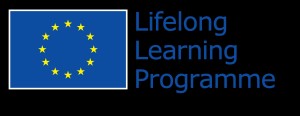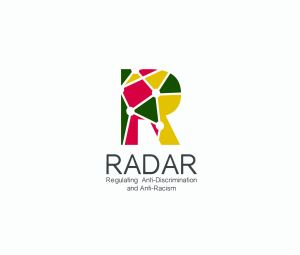
![]()
The Moving Languages English Application launch took place on Friday 8th June at the George Davies Lecture Theatre, Esmée Fairbairn building, Heriot-Watt University.
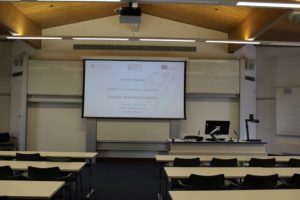
The Moving Languages application is the result of an EU-funded project led by Finnish organisation Learnmera Oy, with LINCS at Heriot-Watt as one of the partners. The app is designed to help new migrants learn the host language(s) and familiarise themselves with culture-specific vocabulary and concepts. A user-friendly, versatile and comprehensive app, it also aims to encourage people to learn other languages and promote understanding between cultures.
Our mission is to help combat linguistic and cultural isolation, which is proven to be one of the key barriers to the successful integration and inclusion of migrants. There are plenty of generic language-learning apps on the market that are not designed for the needs of refugees or newly-arrived migrants. While the Moving Languages app is not designed specifically for these groups, it also caters to them, with features such as:
- Targeted support languages
- Culture tab
- Administration and Immigration tabs
- Dialogues with Audio
This free application provides a gamified language- and culture-learning tool. It contains 4000+ illustrated vocabulary items for easy concept recognition, grammar exercises, flashcards, reading comprehension, listening comprehension, culture, administration, health and immigration tabs, dialogues with audio, audio spelling and comprehension tests and many other features. The app covers topics that are essential during the first steps of living in the host country.
Users can learn English, Spanish, Italian, German, Swedish, Finnish (main languages) from 20 support languages widely spoken by refugees/migrants in partner countries: Albanian, Arabic, Bulgarian, Chinese, Croatian, Estonian, French, Hungarian, Kurdish (Sorani), Polish, Portuguese, Punjabi, Romanian, Russian, Serbian, Somali, Tigrinya, Turkish, Ukrainian, and Urdu. They can also use the main languages as support languages if they wishes. This means that if you download the English app, you can learn English from 25 languages in total.
The UK project coordinator, Dr Katerina Strani, presented the background, the project outputs and the research that led to the development of the app, before hooking up her phone to the projector and presenting the app in real time.
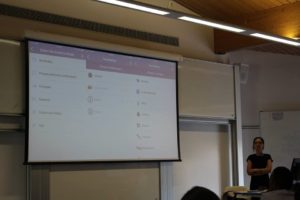
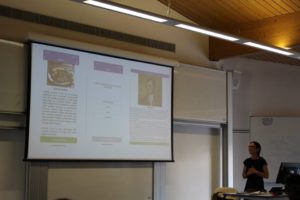
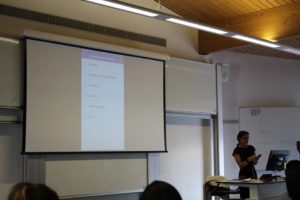
Some feedback from participants in the launch event who tested the app:
“The App is easy to use, you learn a new language and culture in a funny way
Well done.
It’s very self- explanatory, especially the fact that you don’t have to press a continue button after a correct answer makes it very user-friendly.
Easy to use.
It’s very snappy, clear and easy/fluid to navigate.
I think that this application is easy to use and it’s a good way to learn the basic expressions of a foreign language.
Outstanding.
It looks great, well done!
Useful and Innovative: the culture part offers practical information that other language learning apps don’t offer (HS – related info, for example).
This is a very good app. It addresses key issues around language learning and the social inclusion of immigrants.”
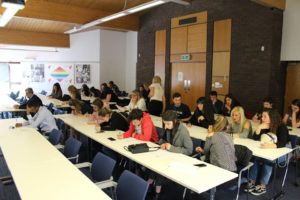
You can download the app here:
iOS https://itunes.apple.com/gb/app/moving-languages-uk/id1389806713?mt=8
Android https://play.google.com/store/apps/details?id=com.ml.english
We would love your comments as we continue to update the app and fix bugs until the end of the project in November 2018. Please give us your feedback here: https://goo.gl/forms/eJwXXtep1BTDz76B2
For more information, contact the UK coordinator, Dr Katerina Strani A.Strani@hw.ac.uk or the project coordinator Veronica Gelfgren Veronica@learnmera.com
Website: http://www.movinglanguages.eu/
Facebook: https://www.facebook.com/movinglanguages/
LinkedIN: https://www.linkedin.com/groups/8580234
Instagram: https://www.instagram.com/movinglanguages/
Twitter: https://twitter.com/MovLanguages
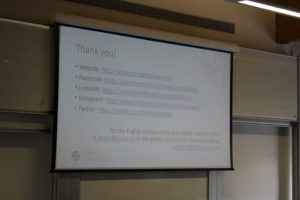
This project has been funded with support from the European Commission under Project No. 2016-1-FI01-KA204-022678






